There is no other type of watch that requires as much interaction from its wearer as the chronograph. Even at rest a chronograph dutifully waits, its seconds hand standing still, alert and vertical, inviting the user to start the stopwatch function.
There's a distinct pleasure that comes from directly interacting with a finely-made mechanical chronograph movement that cannot be had by just winding or setting a conventional watch: You feel the button release under the right amount of finger pressure, hear the satisfying click, and the sweep hand begins its march. There is a tension that builds as the hand approaches sixty seconds again and again and the minute counter ticks over to another hash. Push the button again and time is stopped. Press the reset button and all hands snap back, impossibly fast, ready to go again.
The chronograph, like the wristwatch itself, is largely obsolete. Devised to measure elapsed time and speed, it has been surpassed by superior digital and optical technologies in the arenas where it once was king – the racetrack, the battlefield, the laboratory. But the chronograph remains popular perhaps because it reminds us of that golden age of athletic achievement and exploration, when the four-minute mile was achieved and man set foot on the Moon.
The man who wears a chronograph is a man of action, one who is ready to take a pulse or time an approaching thunderstorm. If you wear a chronograph, you should know its history, how to use it and know how it works. And please don’t confuse a “chronograph” with a “chronometer.” The latter is nothing more than a certification of accuracy, originally deeming a timepiece worthy for use as a navigational device. A chronograph is something completely different.
Writing Time
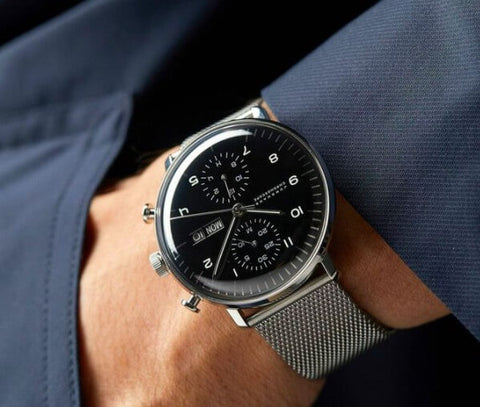
The first chronograph was a simple clockwork mechanism in a box connected to two ink styluses that wrote on rotating discs of paper to compare the times of two race horses on a track. In fact, the word, “chronograph,” literally means, “time writer” and it wasn’t long before its usefulness was realized and watchmakers scrambled to make their own, more portable and more accurate.
At first, chronographs were in pocketwatch cases and did nothing more than act as stopwatches, not telling the time of day at all. You see, it’s easier to develop a stopwatch than to integrate this function with a movement that also keeps the time of day. But by the early twentieth century, thanks in large part to World War I, the pocketwatch made its way onto the wrist and the usefulness of the chronograph was realized.
At first chronographs had only one button, which was co-axial to the winding crown itself. Pushing the button in succession started, stopped and reset the chronograph. But in the 1930s, the Breitling watch company invented the separate pusher chronograph and then a few years later the two-button chronograph, and the industry hasn’t looked back since.
It’s Complicated
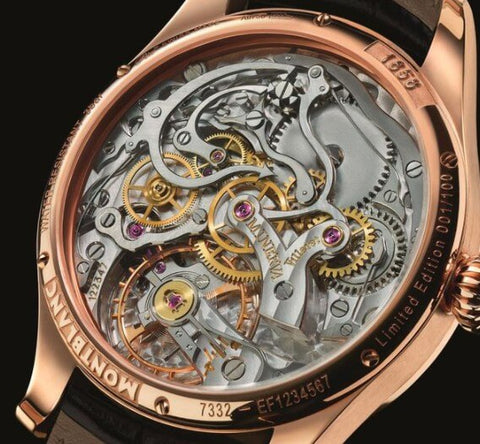
While early chronograph movements were made up of simple mechanical levers, the two most prevalent types of movements that still persist today are referred to as the column wheel and the cam-actuated varieties.
In the column wheel movement, a mechanism that looks like a small castle turret, rotates one increment with each click of the chronograph pusher. A mechanical finger falls between the teeth of the column wheel to activate the functions.
The column wheel movement requires precision in design and build, and the resulting action is perceptible to the user, in the smooth and quick response and is usually visible if the movement is observed. Column wheel chronographs are generally more expensive and not as common but are typically more desirable to watch collectors, due to the level of quality and attention to detail required in their manufacture.
A cam-actuated (or coulisse-lever) movement has its advantages too – it is easier to manufacture and very robust, without the finicky setup and tolerances required in a column wheel. In this type of movement, each push of a chronograph button moves a heart-shaped cam (the coulisee) back and forth to start, stop or reset the chronograph.
The action of a coulisse-lever movement is firmer, requiring more effort to engage and not quite as tactilely pleasurable to operate. However, the vast majority of mechanical chronographs sold today use one type of coulisse-lever movement – the Valjoux 7750, first introduced in 1974 and still very much alive today. Another version, the Lemania 5100 was robust enough to be approved for use in military chronographs and the NASA-approved Omega Speedmaster utilizes a Lemania-based cam-actuated movement.
Two complications that can make a chronograph even more useful are the flyback and the rattrapante. A flyback chronograph allows you to restart the chronograph with a single push of the reset button. A rattrapante, or split-second complication, overlays a second sweep hand that, with the push of a third button, can stop a second event while the first sweep hand continues to run. Resetting the split hand causes it to “catch up” with the first and continue to run in tandem until the split is activated once again.
The Space Race
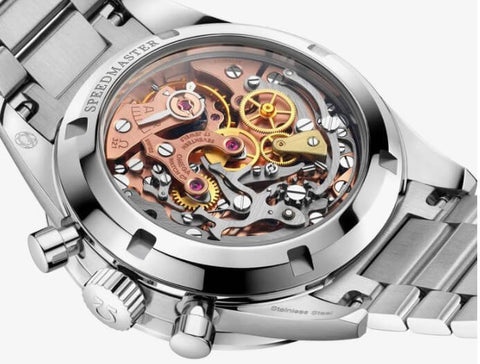
In the late 1960s, while the space race pitted nations against one another in an attempt to reach the Moon, watch companies were racing too – to develop the world’s first automatic chronograph. Up to that point, despite a ubiquity of automatic winding watches, chronographs still had to be hand wound due to the complexity and space restrictions in creating an automatic chronograph.
Three groups crossed the finish line neck-and-neck in 1969. A consortium of Hamilton, Buren, Breitling and Heuer worked together to develop the Caliber 11, an automatic chronograph movement that used a small oscillating weight called a microrotor. Meanwhile, Zenith presented their own auto-chrono, the El Primero (“the first”) which used a full-sized winding rotor. But in Japan, Seiko may have beaten them both with its own automatic, the 6139. Who made it first is still in question. But no matter. Another development the same year had far greater impact – the invention of the battery-powered quartz movement.
Doctors, Soldiers and Race Car Drivers
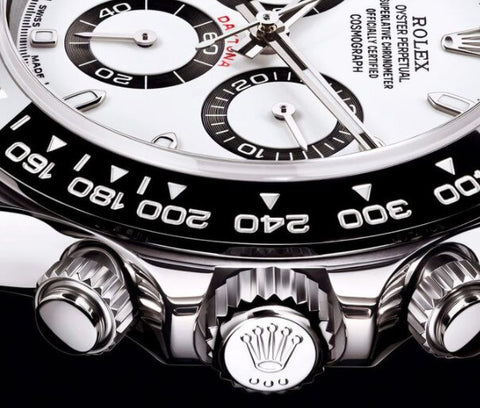
OK, enough about what’s inside your chronograph. What about those scales printed around the bezel? While a chronograph can be useful for measuring elapsed time, with a calibrated scale, it can be used to tell distances, pulse rates and average speeds. There are generally three types of scales printed on the bezels of chronographs and its useful to know how they work, even if only to impress your buddies or not be embarrassed when you’re asked.
The tachymeter scale is used to tell average speed over a set distance and is simple to operate, as long as you have an accurately-measured distance. The easiest way to use it is with the mile markers on U.S. Interstate highways. Start the chronograph when your car passes one of the markers. Stop it when you pass the next marker. The number on the tachymeter scale that corresponds to the sweep hand is your average speed across that distance.
A telemeter scale was devised to help soldiers know how far away artillery fire was. Nowadays, it can be useful for tracking a thunderstorm. Start the chronograph when you see a flash of lightning and stop it when you hear the thunder. The number on the bezel where the sweep hand is stopped is the distance. This scale utilizes the known average speed of sound at a given temperature (10 degrees C) and will vary. But it’s close enough and fun to use.
The pulsometer is perhaps the most useful bezel scale for modern everyday use. Find a pulse, start the chronograph and stop it after counting the number of heartbeats designated on the scale. The resulting bezel reading will be the person’s heart rate. Watches with pulsometric scales are sometimes called doctors’ chronographs, for obvious reasons.
Bi and Tri-compax
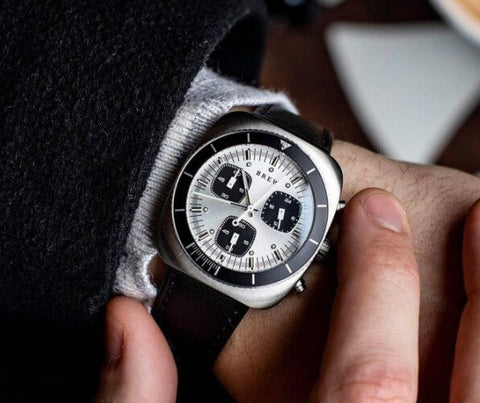
The business end of a chronograph, its dial, is as varied as its use. Aside from the pushers jutting asymmetrically from the side of the case, the distinguishing characteristic of a chronograph is its registers or subdials. These are the counters that keep track of elapsed minutes or hours as well as the watch’s running time seconds.
The traditional layout of subdials, used for many years, is called bi-compax, which means it had two subdials arranged at the 9 o’clock and 3 o’clock positions on the dial, one for minutes and one for the main time's running seconds, with a central chronograph seconds hand.
A tri-compax layout is usually used to add an hours counter at the 6 o’clock position, with the other subdials at 9 and 3 or 9 and 12.
Chronographs that used the now-discontinued Lemania 5100 movement overlaid center sweep hands for seconds and minutes, a very readable arrangement.
Stopping Time
While most of us won’t time anything beyond a boring meeting or boiling eggs, a chronograph is all about readiness, potential and the human interaction with a micro-engineering marvel. And the rare opportunity to stop time.
You may interested in:
How to Remove Scratches from a Stainless Steel Watch Case
11 of the Most Notable British Watch Brands Today
10 COOL AND AFFORDABLE WATCHES FOR MEN
5 Vintage Watches For the Budget-Minded Aficionado


